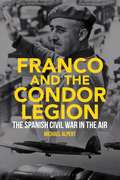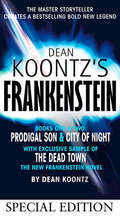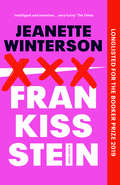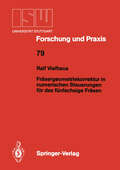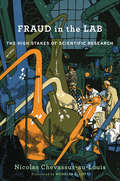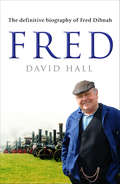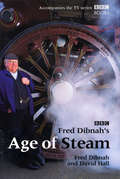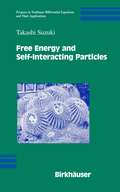- Table View
- List View
Franco and the Condor Legion: The Spanish Civil War in the Air
by Michael AlpertThe Spanish Civil War was fought on land and at sea but also in an age of great interest in air warfare and the rapid development of warplanes. The war in Spain came a turning point in the development of military aircraft and was the arena in which new techniques of air war were rehearsed including high-speed dogfights, attacks on ships, bombing of civilian areas and tactical air-ground cooperation. At the heart of the air war were the Condor Legion, a unit composed of military personnel from Hitler's Germany who fought for Franco's Nationalists in Spain. In this book, Michael Alpert provides the first study in English of the Spanish Civil War in the air. He describes and analyses the intervention of German, Italian and Soviet aircraft in the Spanish conflict, as well as the supply of aircraft in general and the role of volunteer and mercenary airmen. His book provides new perspectives on the air war in Spain, the precedents set for World War II and the possible lessons learnt.
Franco and the Condor Legion: The Spanish Civil War in the Air
by Michael AlpertThe Spanish Civil War was fought on land and at sea but also in an age of great interest in air warfare and the rapid development of warplanes. The war in Spain came a turning point in the development of military aircraft and was the arena in which new techniques of air war were rehearsed including high-speed dogfights, attacks on ships, bombing of civilian areas and tactical air-ground cooperation. At the heart of the air war were the Condor Legion, a unit composed of military personnel from Hitler's Germany who fought for Franco's Nationalists in Spain. In this book, Michael Alpert provides the first study in English of the Spanish Civil War in the air. He describes and analyses the intervention of German, Italian and Soviet aircraft in the Spanish conflict, as well as the supply of aircraft in general and the role of volunteer and mercenary airmen. His book provides new perspectives on the air war in Spain, the precedents set for World War II and the possible lessons learnt.
Frank Whittle: The Invention of the Jet (Icon Science)
by Andrew NahumThe story of the jet engine has everything: genius, tragedy, heroism, a world war, the individual vs. the state, and an idea that would change the world. Frank Whittle always maintained that he was held back by a lack of government support. At the very moment in 1943 when his invention was unveiled to the world, his company, Power Jets, was forcibly nationalised. Yet Whittle's brilliance, charm and charisma helped him recruit major support from the British government and the RAF, who gave him the green light to build a jet engine at a time when to do so made little sense. Here is a story of what pushing technology to its limits can achieve - and the effect that such achievement can have on those involved.
Frankenstein Special Edition: Prodigal Son; City Of Night (Dean Koontz's Frankenstein Ser. #Bk. 3)
by Dean KoontzThe stunning first two instalments of Dean Koontz’s re-imagining of Frankenstein – including an extract from the final book, The Dead Town.
Frankia Symbioses (Developments in Plant and Soil Sciences #12)
by A. D. Akkermans D. Baker K. Huss-Danell J. D. TjepkemaFive years have now passed since the first symposium on frankiae was held at Harvard Forest, Petersham, Massachusetts, USA and the inauguration of the term actinorhiza. Many advances have been made during these five years in our understanding of the actinorhizal symbioses. Evidence for this was provided by the papers presented at the Wageningen Workshop on Frankia symbioses, held in Wageningen at the Department of Microbiology of the Agricultural University. Most of these papers are now published in this volume of PLANT AND SOIL. We kindly acknowledge the assistance of Anton Houwers, editor of the journal, in planning, reviewing and publishing these studies. Although the papers presented at Wageningen described the active research areas, they also illuminated those aspects of these symbioses which remain beyond our understanding. Primary among the areas of our ignorance is the concept of species within the bacterial symbiont, Frankia. At present groupings of bacterial strains are based on cell chemistry, physiology, serology, DNA homology and symbiotic capa bilities (cross-inoculation). When these classification schemes are merged no clear species framework is obtained. Undoubtedly part of the difficulty is due to a lack of strains for analysis. Currently bacterial strains from only half of the actinorhizal symbioses known to exist, have been isolated and studied in pure culture. We must postpone there fore any comprehensive taxonomic classification until a larger majority of the symbioses are represented. Another research area wherein our understanding is insufficient is host-symbiont interaction.
Frankissstein: A Love Story
by Jeanette WintersonFrom 'one of the most gifted writers working today' (New York Times) comes an audacious new novel about the bodies we live in and the bodies we desireIn Brexit Britain, a young transgender doctor called Ry is falling in love – against their better judgement – with Victor Stein, a celebrated professor leading the public debate around AI.Meanwhile, Ron Lord, just divorced and living with Mum again, is set to make his fortune launching a new generation of sex dolls for lonely men everywhere.Across the Atlantic, in Phoenix, Arizona, a cryonics facility houses dozens of bodies of men and women who are medically and legally dead… but waiting to return to life.But the scene is set in 1816, when nineteen-year-old Mary Shelley writes a story about creating a non-biological life-form. ‘Beware, for I am fearless and therefore powerful.'What will happen when homo sapiens is no longer the smartest being on the planet? Jeanette Winterson shows us how much closer we are to that future than we realise. Funny and furious, bold and clear-sighted, Frankissstein is a love story about life itself.
Fräsen: Verfahren, Betriebsmittel, wirtschaftlicher Einsatz (Fertigung und Betrieb #1)
by H.H. KleinFräsen (Refa-Schriften #2)
by Reichsausschuß für ArbeitsstudienDieser Buchtitel ist Teil des Digitalisierungsprojekts Springer Book Archives mit Publikationen, die seit den Anfängen des Verlags von 1842 erschienen sind. Der Verlag stellt mit diesem Archiv Quellen für die historische wie auch die disziplingeschichtliche Forschung zur Verfügung, die jeweils im historischen Kontext betrachtet werden müssen. Dieser Titel erschien in der Zeit vor 1945 und wird daher in seiner zeittypischen politisch-ideologischen Ausrichtung vom Verlag nicht beworben.
Fräsergeometriekorrektur in numerischen Steuerungen für das fünfachsige Fräsen (ISW Forschung und Praxis #79)
by Ralf ViefhausFräsmaschinen im Betrieb (Werkstattbücher #120)
by H.H. KleinDurch eine gute Arbeitsplanung wird der Mensch im Betrieb immer mehr von anstrengenden, eintönigen Arbeiten entlastet und in die Lage versetzt, die Pro duktivität zu steigern und damit auch sein eigenes Einkommen zu erhöhen. Das gelingt aber nur dem, der seine Maschine vollkommen beherrscht und es versteht, die ihm zur Verfügung gestellten erstklassigen Werkzeuge und Einrichtungen voll auszunutzen. Unter den spanenden Werkzeugmaschinen spielen die Fräsmaschinen im Be trieb eine beachtliche Rolle, kann doch auf ihnen eine Fülle vielseitiger Arbeiten wirtschaftlich ausgeführt werden. Es lohnt sich daher für jeden Betriebsmann, Aufbau und Einsatzmöglichkeiten der wichtigsten Fräsmaschinentypen näher kennen zu lernen. Hierbei soll dieses Werkstattbuch behilflich sein. Die folgenden Abschnitte enthalten grundlegende Betrachtungen und prak tische Hinweise, die über die Eigenart der Fräsmaschinen Aufschluß geben. Allen Herstellerfirmen, die hierfür bereitwillig wertvolle Unterlagen zur Verfügung gestellt haben, sei auch an dieser Stelle besonders gedankt. An Hand ihrer Druck schriften und des im Anhang erwähnten Schrifttums kann man sich noch ein gehender in das eine oder andere Teilgebiet vertiefen und Lösungen für besondere Fräsaufgaben finden. I. Aufbau und Kennzeichen neuzeitlicher Fräsmaschinen A. Die wichtigsten Ausführungsarten (Typen) von Fräsmaschinen Die Zahl der Fräsmaschinentypen, die auf dem Markt sind, ist groß. Es macht daher - selbst anband des Schrifttums [ 1-3] - einige Mühe, sich den für die Arbeitsplanung oder Neubeschaffung von Maschinen erforderlichen Überblick zu verschaffen.
Fraud in the Lab: The High Stakes of Scientific Research
by Nicolas Chevassus-au-LouisFrom manipulated results and fake data to retouched illustrations and plagiarism, cases of scientific fraud have skyrocketed in the past two decades. In a damning exposé, Nicolas Chevassus-au-Louis details the circumstances enabling the decline in scientific standards and highlights efforts to curtail future misconduct.
FRCA: New Advances in Flame Retardant Technology
by Fire Retardant Chemicals AssociationThis book compares technical information of various fire retardant coatings for electric cables. It also summarizes various testing methods, with a special emphasis on the Factory Mutual testing standard.
FRCA: New Advances in Flame Retardant Technology
by Fire Retardant Chemicals AssociationThis book compares technical information of various fire retardant coatings for electric cables. It also summarizes various testing methods, with a special emphasis on the Factory Mutual testing standard.
Freche Verse — physikalisch: Physiker und Physik im Limerick, illustriert von Peter Evers
by Peter HägeleWas kommt heraus, wenn ein Physiker seiner Wissenschaft und seinen Standeskollegen von früher und heute auf die Finger schaut und das ganze in Limericks faßt? Eine Sammlung von kurzen, oft überraschenden und lustigen, oft auch nachdenklich machenden kurzen Gedichten, die die Schwächen der Großen und (noch) Kleinen des Faches nicht ohne Sympathie offenlegen. Der Physiker und Zeichner Peter Evers, bekannt durch seine regelmäßigen Beiträge in Sachen humorvoller Physik in den "Physikalischen Blättern", hat fast 30 Karikaturen beigesteuert, die die Welt der Physik ebenfalls mit einigen Schlaglichtern beleuchten. Ein Daumenkino macht dieses Buch sogar zu einem bewegten Erlebnis!
Fred: The Definitive Biography Of Fred Dibnah
by David HallFred Dibnah's World celebrates the life and work of Britain's best known steeplejack and national treasure, Fred Dibnhah. Before his death in 2004, Fred presented many popular series, including Magnificent Monuments, The Age of Steam and Made in Britain, all of which attracted viewers in their millions.Fred is the companion to the 12-part BBC2 series celebrating the life of this great man, which combines highlights from some of Dibnah's classic programmes with previously unseen footage. The book can of course go much further than the series, including an extraordinarily account of Fred's childhood which evokes a lost England and our great industrial heritage. Fred's passion for the glories of the Victorian age and his fascination with the landscape he grew up in, plus his admiration for the craftsmen and labourers who made it all possible, captivate us on every page. Fred is the personification of everything that made England great in the first place. And this is a glorious tribute to a man whom millions came to love.
Fred Dibnah - Made in Britain
by David HallIn 2004, after felling his last chimney and retiring from steeplejacking, Fred took to the road on his beloved traction engine for the BBC series Made in Britain. Travelling the length and breadth of the country, the intention was to seek out the remarkable achievements of the craftsmen, engineers, inventors and industrial workers whose endeavour made engines like Fred's possible. It was a journey that took him to Britain's most iconic engineering marvels as well as less familiar sites: from the Forth Bridge and the Middlesbrough Transporter Bridge to Europe's last deep-working iron ore mine in Cumbria and a local castings workshop in Bo'ness. This behind-the-scenes account of that ambitious journey is made all the more remarkable by Fred's heroic efforts to complete it while suffering from terminal cancer. It is not only a glorious testament to our nation's industrial achievements but also a story of the friendships, unfailing courage and determination of the nation's favourite steeplejack.
Fred Dibnah's Age Of Steam
by David Hall Fred DibnahBritains favourite steeplejack and industrial enthusiastic, the late Fred Dibnah, takes us back to the 18th century when the invention of the steam engine gave an enormous impetus to the development of machinery of all types. He reveals how the steam engine provided the first practical means of generating power from heat to augment the old sources of power (from muscle, wind and water) and provided the main source of power for the Industrial Revolution. In Fred Dibnahs Age of Steam Fred shares his passion for steam and meets some of the characters who devote their lives to finding, preserving and restoring steam locomotives, traction engines and stationary engines, mill workings and pumps. Combined with this will be the stories of central figures of the time, including James Watts - inventor of the steam engine - and Richard Trevithick who played a key role in the expansion of industrial Britain in the 18th and 19th centuries.
Freddie Spector, Fact Collector: Space Cadet
by Ashleigh BartonDid you know that a bolt of lightning is five times hotter than the Sun? Or that slugs have four noses? How about that humans share 50 per cent of our DNA with bananas? Freddie Spector, the world's greatest fact collector, knows all these things and so much more.Freddie Spector loves collecting facts - about anything and everything. His latest obsession is space. It's all he talks about: stars, planets, galaxies, astronauts, space travel - and, of course UFOs and extraterrestrials. Freddie writes all his facts on sticky notes that his mum and big sister, Henrietta, keep finding in weird places - like in their sock drawers or their sandwiches.But whenever Freddie collects facts on a topic, his very active imagination always gets involved too. And, after noticing some very suspicious goings-on, Freddie realises it's up to him to discover the answer to a burning question: could aliens have landed in his neighbourhood?Fast-paced and funny, this series is all about an everyday eight-year-old boy whose love of facts and extraordinary imagination come together with unexpected and hilarious results.
Free and Open Source Software: A Comparative Analysis (Ius Comparatum - Global Studies in Comparative Law #12)
by Axel MetzgerThis book discusses the main legal questions raised by free and open source software (FOSS) licenses and other alternative license models, such as Creative Commons. The legal questions raised by FOSS and other alternative licenses have been the subject of an intense international debate among legal scholars and practising lawyers in the last years. Courts in different jurisdictions have confirmed that the core features of FOSS licenses are compliant with the respective applicable laws and thus enforceable in the respective jurisdictions. What is still missing so far is an in-depth comparative analysis of the legal issues raised by FOSS, Creative Commons and other alternative license on a worldwide scale. This book presents a general report on FOSS licenses and alternative license models to establish common ground and enable comparison between jurisdictions. The general report is followed by 24 national reports covering the world's most important IT-markets. General and national reports use the same structure to facilitate the comparison. The book shows that despite the differences in their origins, all FOSS projects use detailed licenses for the organisation of their communities. It also shows the differences in the proofing of these licenses by courts in some jurisdictions and the tailor-made provisions established by some legislators to solve the legal issues raised by the license model.
Free Convection Film Flows and Heat Transfer
by De-Yi ShangThis book presents recent developments in systematic studies of hydrodynamics and heat and mass transfer in laminar free convection, accelerating film boiling and condensation of Newtonian fluids, as well as accelerating film flow of non-Newtonian power-law fluids (FFNF). A novel system of analysis models is provided with a developed velocity component method and a system of models for treatment of variable thermophysical properties is presented.
Free Convection Film Flows and Heat Transfer: Models of Laminar Free Convection with Phase Change for Heat and Mass Transfer Analysis (Heat and Mass Transfer)
by De-Yi ShangThis book presents recent developments in our systematic studies of hydrodynamics and heat and mass transfer in laminar free convection, accelerating film boiling and condensation of Newtonian fluids, as well as accelerating film flow of non-Newtonian power-law fluids (FFNF). These new developments provided in this book are (i) novel system of analysis models based on the developed New Similarity Analysis Method; (ii) a system of advanced methods for treatment of gas temperature- dependent physical properties, and liquid temperature- dependent physical properties; (iii) the organically combined models of the governing mathematical models with those on treatment model of variable physical properties; (iv) rigorous approach of overcoming a challenge on accurate solution of three-point boundary value problem related to two-phase film boiling and condensation; and (v) A pseudo-similarity method of dealing with thermal boundary layer of FFNF for greatly simplifies the heat-transfer analysis and numerical calculation. A system of practical application equations on heat and mass transfer are provided in each chapter, which are formulated based on the rigorous numerical solutions with consideration of variable physical properties. In addition, in the second edition, other new research developments are further included on resolving an even big challenge associated with investigations of laminar free film condensation of vapour-gas mixture. They involve the novel methods for treatment of concentration- and temperature- dependent physical properties of vapour-gas mixture, and for rigorous solution of interfacial vapour saturation temperature, which have lead to rigorous analysis and calculation results on two-phase film flow velocity, temperature, and concentration fields, as well as condensate heat and mass transfer.
Free-Convective Heat Transfer: With Many Photographs of Flows and Heat Exchange
by Oleg G. Martynenko Pavel P. KhramtsovFree Convective Heat Transfer is a thorough survey of various kinds of free-convective flows and heat transfer. Reference data are accompanied by a large number of photographs originating from different optical visualization methods illustrating the different types of flow. The formulas derived from numerical and analytical investigations are valuable tools for engineering calculations. They are written in their most compact and general form in order to allow for an extensive range of different variants of boundary and initial conditions, which, in turn, leads to a wide applicability to different flow types. Some specific engineering problems are solved in the book as exemplary applications of these formulas.
Free Culture: How Big Media Uses Technology and the Law to Lock Down Culture and Control Creativity
by Lawrence LessigDiscusses the ramifications of copyright law for culture. The author of this book donated a digital copy of this book. Join us in thanking Lawrence Lessig for providing his accessible digital book to this community.
Free-Electron Lasers in the Ultraviolet and X-Ray Regime: Physical Principles, Experimental Results, Technical Realization (Springer Tracts in Modern Physics #258)
by Peter Schmüser Martin Dohlus Jörg Rossbach Christopher BehrensThe main goal of the book is to provide a systematic and didactic approach to the physics and technology of free-electron lasers. Numerous figures are used for illustrating the underlying ideas and concepts and links to other fields of physics are provided. After an introduction to undulator radiation and the low-gain FEL, the one-dimensional theory of the high-gain FEL is developed in a systematic way. Particular emphasis is put on explaining and justifying the various assumptions and approximations that are needed to obtain the differential and integral equations governing the FEL dynamics. Analytical and numerical solutions are presented and important FEL parameters are defined, such as gain length, FEL bandwidth and saturation power. One of the most important features of a high-gain FEL, the formation of microbunches, is studied at length. The increase of gain length due to beam energy spread, space charge forces, and three-dimensional effects such as betatron oscillations and optical diffraction is analyzed. The mechanism of Self-Amplified Spontaneous Emission is described theoretically and illustrated with numerous experimental results. Various methods of FEL seeding by coherent external radiation are introduced, together with experimental results. The world’s first soft X-ray FEL, the user facility FLASH at DESY, is described in some detail to give an impression of the complexity of such an accelerator-based light source. The last chapter is devoted to the new hard X-ray FELs which generate extremely intense radiation in the Angstrøm regime. The appendices contain supplementary material and more involved calculations.
Free Energy and Self-Interacting Particles (Progress in Nonlinear Differential Equations and Their Applications #62)
by Takashi Suzuki* Examines a nonlinear system of parabolic PDEs arising in mathematical biology and statistical mechanics * Describes the whole picture, i.e., the mathematical and physical principles * Suitable for researchers and grad students in mathematics and applied mathematics who are interested in nonlinear PDEs in stochastic processes, cellular automatons, variational methods, and their applications to physics, chemistry, biology, and engineering
